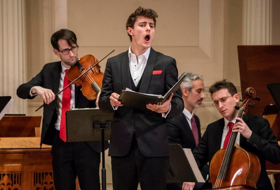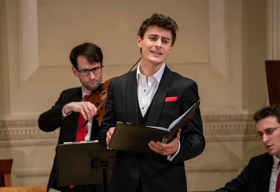Review: Countertenor JAKUB JOZEF ORLINSKI Goes for Baroque at Carnegie's Weill Recital Hall Debut

of New York Baroque Inc. Photo: Stephanie Berger
It wasn't so long ago that countertenors were still considered an oddity--the voice that sounds like a woman in the body of a man playing male characters in the operas of composers like Handel (rare enough until fairly recently). Today, you can't turn around without tripping over one, or more.
Last year, for instance, when the English Concert did Handel's RINALDO at Carnegie Hall there were, indeed, three countertenors. One of them was the young Polish singer--he's 28--Jakub Jozef Orlinski, who made his New York debut at Carnegie's Weill Recital Hall a few nights ago to what I can only describe as a rapturous reception. I agreed.

Photo: Stephanie Berger
The program, in conjunction with members of the New York Baroque Inc. ensemble (who played no small role in the evening's success), started and ended with Vivaldi: Surprisingly, he chose to start on a somber note, with the delectable yet undeniably melancholy "Stabat Mater in F," which has become almost standard rep over the past few years. In combination with the Baroque players, Orlinski painted a lament of exquisite beauty, ending in a fugue of hope.
The evening became more upbeat from there, including the sunny and sweet (yet hypnotic) "Tam non splendet," a motet for alto and orchestra that was the first of two pieces by Nicola Fago, who worked in Naples at the start of the 18th century. The singer's immaculate coloratura in the opening of the piece was a joyful interlude, before he moved on to the more thoughtful second and third movements, and then a virtuosic "Alleluja" that again showed off the flexibility of his voice.
The other Fago, "Alla gente a Dio diletta" comes from the oratorio, "Il Faraone sommerso," from the biblical tale of Moses, Pharaoh and the crossing of the Red Sea, showed more of Orlinski's virtuosic powers of flexibility, along with some gorgeous playing by the ensemble's cello and first violin.

Photo: Stephanie Berger
The program included a world premiere performance ("or the first in 300 years," according to the singer), Gaetano Maria Schiassi's "A che si serbano" from his oratorio, "Maria Vergine al Calvario," which didn't make it to the singer's recent Erato CD, "Anima Sacra," which was the basis of a large part of the program. It was another jubilant piece showing off the singer's vocal dexterity, filled with runs and roulades, jumps and jests.
Schiassi's "L'agnelletta timidetta," from the same work, had a totally different sound, with a luxurious musical line in a pastoral mode, and showed off the composer's beautiful orchestral work as well. This was followed by the dramatic, emphatic "Mea tormenta, properate!" by Johann Adolph Hasse, which showcased yet another side of the performer's art, as it alternated with a more thoughtful and peaceful middle section before reaching its high-flying ending.
After Francesco Durante's "Domine fili unigenite" from "Messa a 5 voci in C Major" (he had also been represented by his "Concerto for Strings," which the ensemble performed brilliantly earlier in the evening), the program ended with the gorgeous "Vedrò con mio diletto," an aria from Vivaldi's "Giustino," RV 717. The piece has become something of a calling card for Orlinski; a video of a live performance that appeared on France Musique from Aix-en-Provence quickly racked up more than two million hits, and it's easy to see why, with his seamless vocal line and elegant phrasing. (His classic good looks didn't hurt, either.)
I first spotted Orlinski in 2016 at Juilliard as the shepherd, Endimione, in Cavalli's LA CALISTO, a production of their early music program, and it set my head spinning. The magical sound that came out of him was different from any I'd heard before, richer and less foreign to the modern ear than I was used to hearing from countertenors.
I heard him again as Ottone in Handel's AGRIPPINA and--just to make it clear that he's not stuck in the 17th and 18th centuries--as the Refugee in Jonathan Dove's FLIGHT. I frankly prefer him in Vivaldi, Fago and Corelli, which better show off his breath control and flexibility as well as the beauty of his tone...but one can't live forever in the past.
Indeed, while the concert at Weill recital Hall was filled with innumerable joys, I look forward to hearing Orlinski again--soon--in something more substantial that gives him the chance to show off his acting skills as well as his musical chops.
The participating members of New York Baroque Incorporated were Aisslinn Nosky (violin, leader), Alexander Woods (violin), Kyle Miller (viola), Ezra Seltzer (cello), Wen Yang (violone) and Avi Stein (keyboard).
Videos

